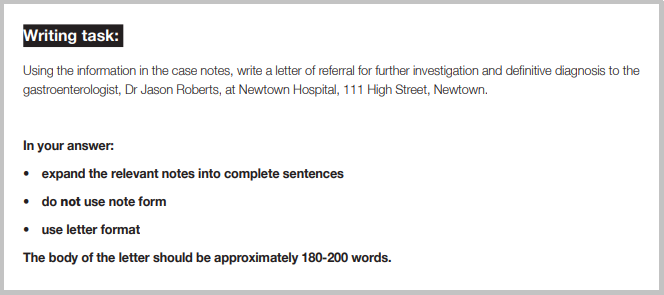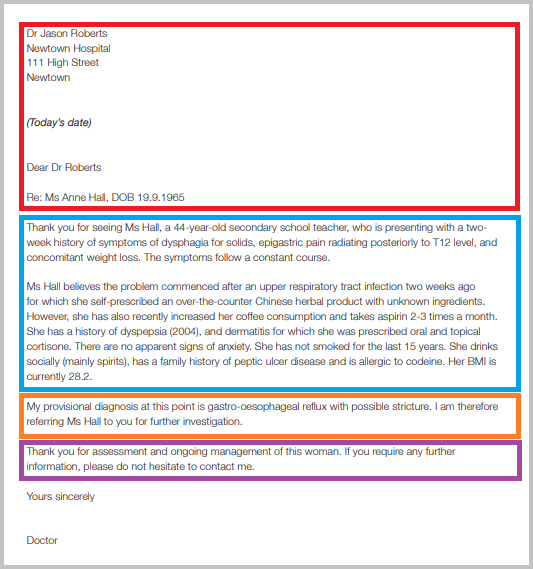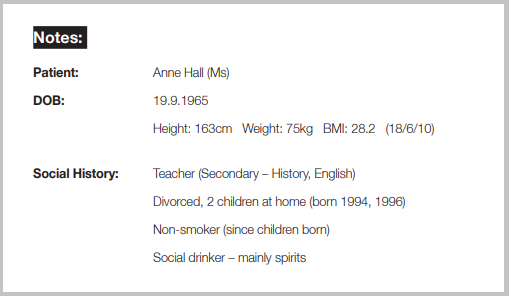[vc_row][vc_column][vc_column_text]The OET writing exam will require for you to write a letter of around 180-200 words regarding a patient.
This task is similar for both nurses and doctors however each will write a letter specific to their profession.
You will be given:
- The task (this explains what you must do, for example: Write a letter regarding Mr Smith who is being discharged from hospital back to his nursing home.)
- The patient’s case notes and full medical history
The OET writing exam can be difficult.
However, the good news is with these 5 tips you can quickly improve your letter.
1. Understand the writing task
The first thing you should look for is the writing task.
You can see an example of one below.

This box explains:
WHO you will need to write to and the TYPE OF LETTER you must write.
In this example you are writing to Dr Jason Roberts at Newtown Hospital and it is a REFERRAL letter.
[vc_row][vc_column][vc_message message_box_style=”solid-icon” message_box_color=”alert-info”]While the word count is 180-200 words you will NOT lose marks for writing more or less than this. The word count is given for guidance only. We would however recommend to aim for 180-250 words in order to focus your letter and to not write too much or too little.[/vc_message][/vc_column][/vc_row]
There are three common types of OET writing letter:
[vc_row content_placement=”middle”][vc_column width=”1/3″][vc_single_image image=”9352″ img_size=”100×100″ alignment=”center”][vc_column_text]
Referral
This means the patient is going to another healthcare facility for a different kind of investigation or treatment.
[/vc_column_text][/vc_column][vc_column width=”1/3″][vc_single_image image=”9351″ img_size=”100×100″ alignment=”center”][vc_column_text]
Transfer
This means the patient is going to another healthcare facility or department for to continue their treatment.
[/vc_column_text][/vc_column][vc_column width=”1/3″][vc_single_image image=”9350″ img_size=”100×100″ alignment=”center”][vc_column_text]
Discharge
This means that the patient will now be leaving your healthcare facility or clinic and will be going home.
[/vc_column_text][/vc_column][/vc_row]
It is vital that you take the time to recognise these letter types and to get an idea of how they affect the letter. You should get into the habit of asking yourself:
- Who am I writing to?
- What has happened?
- Who am I writing about?
- What type of letter is it?
2. Understand the case notes

As advised by the OET exam board, the next thing you will need to do is study the case notes.
The first five minutes of the exam are for reading the case notes only. You will not be allowed to start writing until this time is up.
The main difficulty with this is that the writing case notes are not written in perfect sentences and might be challenging to understand.
It is your job to understand these case notes and to transform them into grammatically correct sentences.
For example a case note which reads:
| NURSING MANAGEMENT AND PROGRESS | daily dressings surgery incision site |
What exactly are they asking here?
‘Nursing management relates’ to what the patient will require in the future to manage their symptoms.
‘Daily dressings’ refers to changing the patient’s bandages and ‘surgery incision site‘ refers to the wound where the surgery was performed.
We might therefore write:
To continue the patient’s care, he will require for his bandages to be changed everyday at the site of the surgery.
Of course there is no set rule of exactly how to explain this information however you should try to use all of the relevant details within the case notes and to ‘transform’ them into sentences with good grammar and
3. Know your abbreviations
OET writing case notes may also use abbreviations.
[vc_row][vc_column][vc_message message_box_style=”solid-icon” message_box_color=”alert-info”]Abbreviation means a shorter form of a medical vocabulary or phrases. For example ‘BP’ instead of ‘blood pressure.'[/vc_message][/vc_column][/vc_row]
What do the abbreviations mean in this example?
| PHx | pt. suffered with heart attack – 4-yr |
In this case ‘PHx‘ refers to ‘patient history’. While ‘pt‘ means ‘patient’ and ‘4-yr‘ means ‘4 years ago’.
This sentence might therefore read in your letter as:
The patient’s history shows that Mr Smith suffered from a heart attack four years ago.
In your letter you will not be using abbreviations. You should instead expand on the abbreviations and turn them into full sentences.
Other common abbreviations in the writing exam are:
- BMI = body mass index
- OTC = over the counter
- r/v = review
- ICU = intensive care unit
- SOB = shortness of breath
During your studies if you come across an abbreviations you haven’t heard before, you can find this useful dictionary of common medical abbreviations to study what they mean.
4. Choose relevant information
The letter you are writing will likely be less than 300 words which isn’t very long (especially when compared to IELTS).
You will however be given a page and a half of case notes, meaning:
You should not include all of the case notes in your letter. Some will be relevant and will not be.
A general rule is: only include information that is relevant to the patient’s illness.
Consider this case note:
Let’s assume that this patient’s condition is DIABETES.
Which of these cases notes would be relevant here?
- The patient’s date of birth is essential information and will need to be included in each letter.
- The patient’s weight and BMI is important when relating to diabetes. Patients with a higher BMI are more likely to have diabetes.
- ‘Teacher’ is NOT RELEVANT. The fact this woman teaches History and English is not relevant to her illness.
- Likewise, the fact she is divorced and has two children is NOT RELEVANT to her condition.
- ‘Social drinker’ and ‘non-smoker’ may be relevant as there may be some connection between a healthy lifestyle and diabetes.
Let’s instead assume the patient’s condition is instead DEPRESSION.
Which of these cases notes would be relevant here?
- The patient’s date of birth is essential information and will need to be included in each letter.
- The patient’s weight and BMI is likely NOT RELEVANT when related to depression. (Although with a patient with a very high BMI, there may be reason to mention this information).
- The patient’s occupation as a teacher is likely NOT RELEVANT here. However, a patient with a high stress job may sometimes be relevant.
- ‘Divorced’ is likely relevant and may be related to the patient’s feelings of depression.
- Likewise, the patient’s social drinking would need to be connected to the depression as it is a related case note.
It is up to you to choose which notes are most relevant. We always advise our students to ask themselves:
If I was receiving this letter from another professional, would I want or need to know these details?
5. Plan your writing structure
UPDATE: Check out our new video released in 2020 about OET writing structure!
Once you have decided which case notes to use (see Tip 4 above) you will need to structure them within your letter.

The start of your letter
The top of your letter should include:
WHO we are writing TO and their address.
You can see an example of this highlighted in red above.
After this, you need to include the date. If there is an appropriate date cited in the case notes, use this. If not, use today’s date. For example: 12th February 2017 or 07/08/2018
Followed by “Dear RECIPIENT’S NAME,”
You should finally also follow this up with WHO your letter is REGARDING (Re:) and their DATE OF BIRTH/AGE.
For example: Re: John Smith, DOB: 04/03/1948 or Re: Mary Jones, aged 79 years.
The middle of your letter
The first paragraph should state: Why are you writing, patient name, date of event, hospital, medical condition and what type of letter is it?
There is no set rule of how to do this however you can find some examples below.
“I am writing regarding Mr Smith who is being discharged from London City Hospital on 01/01/2019 after a myocardial infarction.”
“I am contacting you in regards to Mr Lionel Ramamurthy who was admitted to Newton Hospital on May 20th 2019 with a provisional diagnosis of renal failure. I am referring this patient to your care for further treatment and investigation.”
DISCHARGE LETTER: The next paragraph should explain what happened to the patient when they were admitted. Did the patient have difficulty breathing? What were the symptoms? What were the results of tests?
TRANSFER LETTER: Similarly the second paragraph should include what happened to the patient. What symptoms do they have? What medication has been given?
REFERRAL LETTER: The second paragraph should include a timeline of what happened to the patient during the course of their treatment. For example, “The patient presented on 01/01/2018 with a history of a sore throat… Three weeks later this developed into…”
The end of your letter

In the next paragraph you should discuss any further relevant information that the recipient of the letter should know about. What is the patient’s medical history? Are they on any medication? What is their general progress?
Each paragraph of the next one or two paragraphs should have its own ‘theme’ or ideas, meaning one might be about the patient’s lifestyle while the other is about the patient’s medical history.
The final paragraph should explain any further tasks the recipient needs to undertake. Do they need to book the patient in for an appointment? Do they need to monitor his diet or blood sugar levels?
You should end your letter with:
Please do not hesitate to contact me if you have any questions.
Yours sincerely…
(Your profession)
You do not need to include your name on the letter, only your profession.
How are you finding the writing exam? We’ll be releasing another article soon focusing on the common grammar mistakes that students make.
If you are finding the OET writing exam difficult, you might be interested in our OET writing correction service. This involves sending your work to our teachers for detailed feedback and corrections.
We’d love to hear from you. Feel free to ask us any questions in the comments below and our teachers will get back to you.


